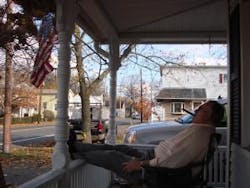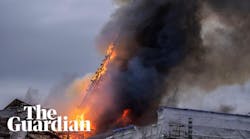Over the past several years, I have seen a certain diminution in the level of fire protection that exists in a number of areas. I have seen this in communities of every size. I have seen this in career, and combination, as well as volunteer departments. Far too many appear to be taking a hit from their political and administrative leaders.
As an observer of the fire service scene, I have chosen to take a close look at the reasons why fire departments appear to take a disproportionate hit at budget time. We must all recognize a number of things:
· Crime pays (at least for police budgets)
· Fire departments are unaware of how big they should be, how many people they should utilize, or how much equipment they need
· The average fire person does not seem to care about the larger picture of protection within their community
· There are those who fail to see the fire service as a multi-service discipline (This amplifies the above statement)
One can only marvel at the amount of money which is available for police departments, and that seems to flow in an endless stream from sources that seem almost mythical to a poor old fire service slug like myself. It is tough to find a culprit to pin this one on.
I guess each of us must share a bit of the blame, because we have not fought to establish grants programs with the same intensity as our colleagues in the police world. We are working to address that problem in Congress, but there are a host of other places, both public and private, that we need to cultivate.
Hell, why not say what every one is thinking. The federal government is taking our FIRE Act money and siphoning it into that vast reservoir of terrorism money. Terrorism my aunt Hanna, I am sick of hearing about terrorism. Most people I know are responding to car wrecks, heart attacks, and house fires. However, I suggest that rather than crying foul, we need to refocus how we do business.
Enough crying over past tankers of spilled milk. If we are to take our place in the world of government affairs, we must begin to operate in a far more organized fashion. Here is where we need to demonstrate that we can operate like a business. If we are all to be in a position that allows us to develop fire departments truly representative of the communities they protect, we must become intimately familiar with risk analysis and community defense fire plan development.
We must adopt a system that allows us to assess the need for fire department, in terms that are readily understandable. We must discover just how many people, pieces of fire apparatus, stations, and the like, are right for our community.
Development of a fire risk assessment of the hazards within any community requires that a determination be made regarding those events that might occur in that community. If a department fails to give this potential emergencies due consideration, their ability to respond to them, should they occur, will be limited. It may also reduce the effectiveness of their overall level of municipal fire protection.
Every fire department should consider adopting a pro-active approach to planning for those potential incidents that may happen in the future. You cannot expect that the future will always be kind to you. You must envision that bad things that could happen and prepare for them.
A great deal of what I exists in each community is there as a result of past practices. More time needs to be spent in planning for future operations. A number of variables exist that can serve as the basis for various potential emergency scenarios. Each must be consciously considered as a part of the planning process. They are as follows:
· Population
· Geography and topography
· Demographics
· Transportation mediums
· Level of industrial development
· Level of residential development
· Level of commercial development
· Predominant construction types
· Available water supply
These are the factors that affect how much fire protection will be needed in your community. Let me assure you that there is a direct relationship between an increase in the number of people who live in you community, and the number of emergency service responses that will occur in your area. I have seen this time and again as new developments have opened here in my fire district.
My area here in Adelphia is no different than any other place in the world. If there are more houses, there exists a greater potential for problems. Even if the percentage of chance in any single home remains the same, there are a lot more places for that chance to occur. It is better to prepare for what may occur than to be cause short.
In line with this, a solid plan for the future will allow you to budget for growth over time. It is better to increase your requests a little bit each year than to be faced with a sudden jump of major proportions. Let us look at how each of these might be addressed in a target community.
1. The population has demonstrated potential for growth.
2. The demand for service has the potential for growth.
3. The changes occurring in your community may have a negative impact upon your ability to recruit new members for the fire department.
4. There has been an increase in the number of residential occupancies.
5. Commercial development has entered a new growth stage.
6. Your road network does not allow for ease of apparatus movement throughout the entire community.
7. Your new residents require the assistance of the fire department to understand the unique safety skills of living in a suburban setting.
8. I observed each of the following transportation and movement mediums during our visits:
a. Roads and highways
b. Aircraft over head (Heavy air traffic from your local airport)
c. The impact of the transport mechanisms must be a part of your planning for future emergency service needs.
9. The potential exists for the development of multiple dwelling residential occupancies that could occur in response to low-income housing concerns been seen at the state level.
10. It has been my experience that where you have an increase in a given population base that this normally translates in an increased potential demand for service.
11. Most new construction is of a type that is not friendly to firefighters.
12. This creates structural integrity problems, as standards have been diminished to some extent by those construction and materials practices that are allowed by the building code minimum requirements.
13. This problem can be partially attenuated through an increased emphasis on installed alarms, and automatic suppression devices.
14. A limited area is protected by fire hydrants. This may grow with an increase in development. Fortunately, a number of water system improvements are under way.
Once the issues like this have been addressed, you must assess what the community will demand of you. You do this by laying out a series of possible events that might occur. Here is an example from a recent consulting job performed by my firm.
After giving each of these criteria a due level of review and concern, I offer the following for your guidance. I believe five basic scenarios exist that merit additional thought on the part of fire department planners in your community.
· A multiple-dwelling fire
· An industrial/commercial/institutional occupancy fire
· An aircraft crash
· A transportation/haz-mat highway incident
· A large-scale, multiple-casualty emergency medical response on the highways of your township.
Once this is completed, you must assess exactly what your fire department can do with regard to these potential incidents, as well the Target Hazard threats in you area. Target Hazard have been defined as being those occupancies that pose the undue risk of life loss, personal injury, or property damage. Hospitals, nursing homes, hotels, lumberyards, schools, and garden apartment complexes are some of the more common examples of Target Hazard occupancies. A fire department will face large-scale human or property challenges in these sorts of properties.
Just what can you fire department do? Do you have enough people? Are there a sufficient number of apparatus to provide the necessary tools and water? Do sufficient people respond on a regular basis? Are your stations properly positioned to protect your community? Each of these questions must be explored and answered in a satisfactory manner.
If you are short of people, what do you do? How does one get more volunteers? How might you increase your career staff? Only you can answer these questions for your community. The same holds true for every other part of this equation:
People + Apparatus + Water + Tools + Labor = Effective fire protection.
You must not put off until tomorrow what should be done today. The answers to these questions are neither cheap nor easy to solve. Ignore them at your own peril.






